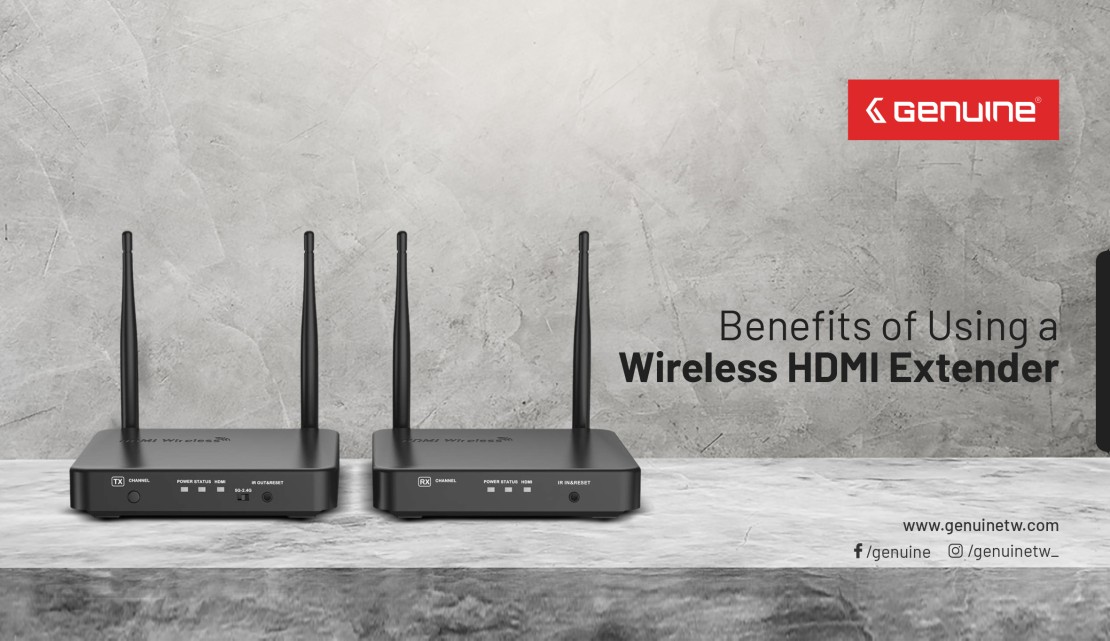
Benefits of using a Wireless HDMI Extender
Wireless HDMI involves transmitting HD video and audio from your source device, such as a cable box, Blue-Ray player, or laptop, to a TV, monitor, or projector, wirelessly
What is a Wireless HDMI Extender?
Wireless HDMI involves transmitting HD video and audio from your source device, such as a cable box, Blue-Ray player, or laptop, to a TV, monitor, or projector, wirelessly. With a traditional HDMI extender, a transmitter and receiver pass data via an ethernet cable or coaxial cable, but a wireless HDMI extender uses the frequency waves all around us. It is comparable to how routers provide a WiFi signal for our computers to wirelessly communicate with other computers and servers. Think of your router as a transmitter and laptop as a receiver. Instead of connecting these using an ethernet cable to communicate, you use WiFi. Same for wireless HDMI. Instead of using an ethernet cable to connect a transmitter and receiver in a traditional HDMI extender kit, you use a wireless connection. However, this wireless handshake is not using WiFi to make a connection. This can easily be misconstrued.
Some Advantages
- Cable Clutter Relief. Cables create an unattractive and potentially dangerous environment. You could trip and fall on the cords and they don’t exactly compliment your base boards nicely.
- Ease of Setup and Adjustment. Simply connect your media device to the transmitter and display to the receiver, then turn on all devices. No need to run a long ethernet cable through, around, over, and under obstacles. Want to move the receiver to another display? Do it without the inconvenience of dragging a long ethernet cable around.
- Placement Flexibility. Wireless HDMI extenders provide the ultimate flexibility when it comes to placing your source device and display where you want. You can bypass wired solutions that confine you to locations based on available cabling, while keeping your source equipment in a secure location. Wireless HDMI can extend video and audio to hardly accessible locations where cabling and drilling though walls isn’t practical. Optimize the viewing experience for audiences at a presentation, sermon, demo station, etc. by enhancing the placement of your display.
- Save Time and Resources. Avoid the cost and time of installing a complex and expensive wiring infrastructure. Best of all, one never has to reinstall cabling to adjust device/display placement. Just move the transmitter and receiver to the desired locations in minutes.
- No WiFi Needed. A common misconception is that a wireless HDMI system is dependent on a WiFi network. As explained before, this is not the case, so one doesn't have to worry about bandwidth consumption over one’s network and doesn’t have to worry about the internet cutting out and losing signal.
Home and office technology continues to advance at a quick pace, and it is hard to always discern if certain tech gadgets are useful or just another trendy flash in the pan.
In such an environment it is easy to see the benefits of using a wireless HDMI extender in the home or at the office, as it is a clear-cut example of useful tech. This set-up allows you to transmit HD data from the source to a television or another monitor, all without wires. This technology is especially helpful when the TV/monitor is located in a different room than the source device as they are able to transmit through walls.
The Basics
The wireless HDMI extender will transmit from a source to an outside display device up to 650 or so yards. What may be counterintuitive is the fact that WiFi is not required, nor is there any software to deal with; the best models are plug-in and go. Sourcing copper cables longer than 50 feet can be problematic and expensive. If the HDMI transmitter is needed in a conference room for example accommodations will need to be made to drop the cables below the floor or attach them to the baseboards, thus adding to the project's expense.
Additional Consideration
There may be a fractional amount of lag time but nothing that is noticeable to the naked eye. The latency rate is equal to the time of a camera flash, so unless you are living in a nanosecond world, you shouldn't notice this at all. Wired installs can be time-consuming and costly. If you are looking to screen HDMI audio and video, you could be looking at some serious cash outlay for copper cables. The utilization of an HDMI over wireless device negates the need for cables which in addition to their cost, are unsightly. And we all know that shared equipment in the workplace makes equipment such as HDMI connectors prime targets for loss and confusion.
Buy HDMI Cables for Best Price in UAE at Genuine.
